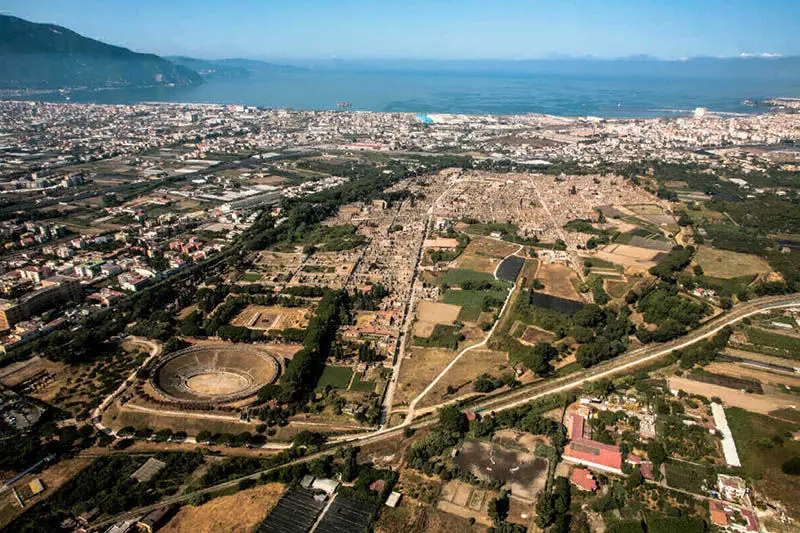
Audioguide 1 - Introduction
We begin our journey of discovery in the city of Pompeii with a brief introduction from the audio guide.
One fine day in 1550, while digging a new course for the Sarno River south of Naples, the Italian architect, Domenico Fontana, found a surprise under his feet: Pompeii, one of the most important cities of Classical Antiquity. Since then, archaeologists have not stopped working to bring the city we are going to visit back to life.
Geographically, we are in southwest Italy, in the Campania region, and at the foot of Mount Vesuvius, an active volcano that has many tales to tell. This mountain has given its name to the Vesuvian volcanic explosions, which are characterized by the formation of clouds that turn into ash precipitation, which can even bury entire cities.
It looks like a movie, doesn't it? Well, that's what happened with Pompeii.
The city of Pompeii, along with the nearby towns of Herculaneum and Stabia, was buried by the ashes of a powerful explosion from the nearby volcano in 79 A.D. Oh, yes, right in the heart of the Roman Empire, surprising the inhabitants in the midst of their daily chores.
This powerful catastrophe destroyed the city's life, but beneath the ashes, the Roman civilization of that time remained intact.
Shall we go in?
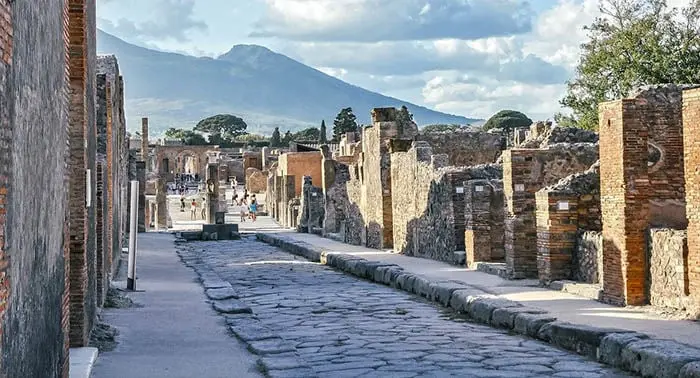
Audioguide 2 – The Roman Amphitheater
We enter the remains of the ancient city through Porta Nocera, guarded by Tower III, located in Region II.
No wonder Pompeii has been declared a UNESCO World Heritage Site! The fact that it is practically intact gives us a very clear idea of what life was like here.
One of the best-preserved places we can visit with the audio guide is the Amphitheater. This public place was very common in Roman civilization.
With a circular shape and a stage in the center surrounded by stands, it was used to host shows and games.
Does it remind you of anything? ... If in the future someone were to study larger and more frequented places of entertainment from our time, where the public would cheer from the stands, what would it be? Indeed: a stadium, or a sports pavilion!
Something like this happened with the Amphitheater, but the difference is that its shows were based on animal and gladiator fights.
The Amphitheater of Pompeii, called "spectacula" by its inhabitants, was built in 70 B.C. and is the oldest discovered to this day. In fact, it is the first one built of stone. Do you know what material they were made of before that? Wood. The Romans must have been very brave to sit on those steps with the fierce beasts below them.
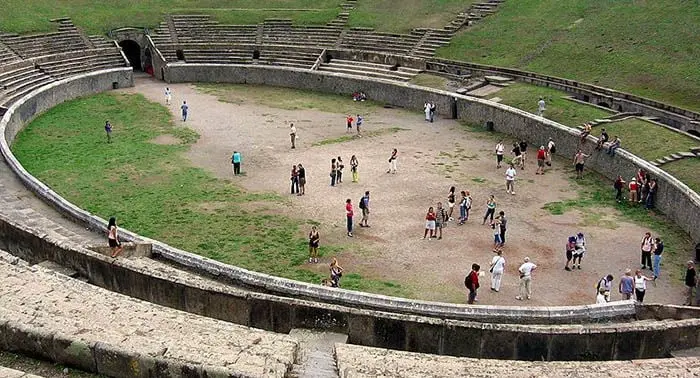
Audioguide 3 – The Grand Palestra
Currently the word "palestra" in Italian means "gymnasium." But in ancient times this word had a much broader meaning, which we will now discover with the audio guide.
The arena was used mainly as a wrestling school since it was one of the most important Greek sports. But later, with the Roman spirit, sports began to be united with the worship of body and mind and had an educational and social role. So, the arena was not only an athletic center but also a cultural center.
Architecturally, it consisted of a rectangular building with columns along its four sides, with porticoes leading to adjoining rooms. These cubicles offered protection from the rain and could be used as dressing rooms or storage rooms.
On the other hand, if we look at the center of the arena we can see a square recess, which was filled with water and served as an essential element for training, a kind of pool.
And what about the decoration of the floors and walls? We currently have pictures at the gym with motivating phrases like "Don't give up" or the classic Arnold Schwarzenegger poster that will never go out of style... Come to think of it, we humans are not very distant from each other, no matter how many centuries go by. Here, Pompeians adorned their arena with famous athletes, gods, and heroes, such as Hercules or Apollo.
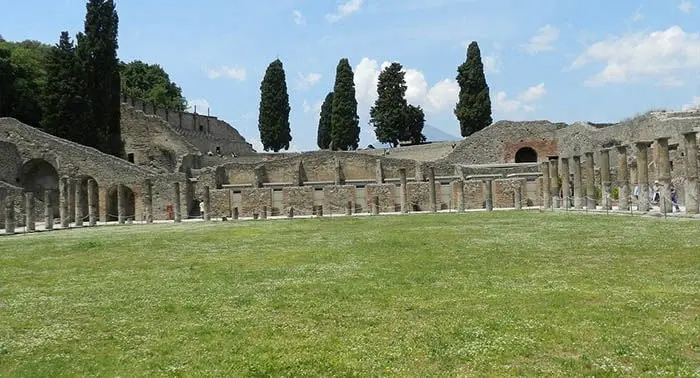
Audioguide 4 – The Frescos
The frescoes in Pompeii are paintings made with a Roman technique of the same name: fresco painting.
This type of art is characterized by painting on a surface of two layers of lime, sand, and water. The first layer is thicker as it is made of river sand; and the second is thinner as marble dust is used instead of sand.
In short, these two layers are covered with paint when they are not yet dry, so the colors penetrate the surface deeply.
The greatest complexity, and therefore the greatest merit of this technique, is that it cannot be corrected over what is already done. Once the paint is applied, it is immediately absorbed, and to correct it another substance is needed, thus losing its properties, and becoming what is called "false fresco."
On the other hand, it is also an achievement for the artist to guess the final color of the work, since the color applied to the wet surface has nothing in common with the color left when it dries.
A very famous work made in fresco, for example, is "The Last Judgment," by Michelangelo in the Sistine Chapel. The vast majority of Pompeian frescoes are preserved and exhibited in the Archaeological Museum of Naples, but here in Pompeii we can see very well preserved works too, such as the Fresco of Leda and the Swan, or the frescoes of the House of Venus at La Concha, among others.
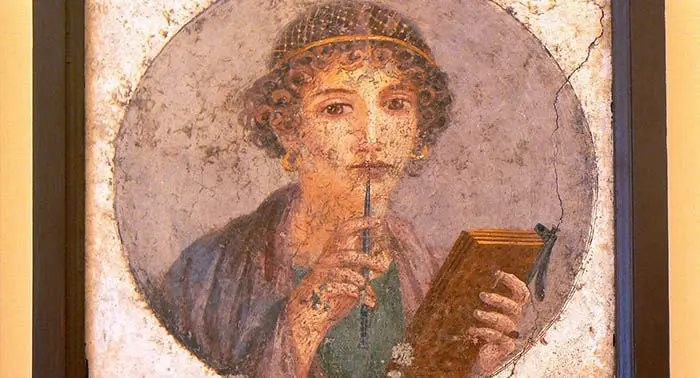
Audioguide 5 – The Castellum Aquae
Located in region VI, in front of the Vesuvius door in the highest part of the city, we find this Roman building that translates to "The water castle."
The "Castellum Aquae" received water through an aqueduct, which in this case was the Serino aqueduct. At more than 96 km in length, it supplied water to eight cities in the Bay of Naples, including Pompeii.
In the city we are visiting with the audio guide, this building is one of the best-preserved of its time, with a 6m diameter vault above the circular floor in the center. Its water cistern housed three sectors that distributed water to different points of the city: one to the fountains, another to the private houses, and another to the public buildings.
And since the Pompeians always had their gods very much in mind, here, as an example, a fresco was painted on the north wall, representing river divinities.
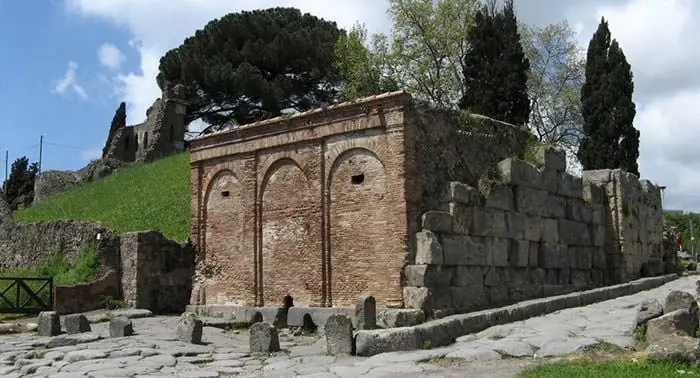
Audioguide 6 - The House of the Faun
At another point in our audio guide, we talk about several houses, but in this one, we focus on a specific one, which deserves special mention.
The House of the Faun dates back to the 3rd century B.C. At first, it was a large orchard with a house, but in the 1st century, it was enlarged by taking advantage of the neighboring plots of land and not done unobtrusively. Including its addition, it occupied the whole block and an area of 3000 square meters.
With these dimensions, who doesn't have a "peristyle" in their house? A peristyle is a patio surrounded by columns around which rooms are arranged. This house has 3!
The house is divided in this manner into five main areas: Three of them are peristyles: the first one of the Ionic order, the second one Doric and finally, an atrium with peristyle, that is, an inner courtyard with columns. The other two areas are the Tuscan atrium and the service rooms.
In the Tuscan-type atrium, there is a pond that used to collect rainwater, in the center of which there is a statue of a dancing faun, which gives its name to the house. This small statuette has been described as the highest quality bronze sculpture found in Pompeii, because of its delicacy and characteristics.
Other main pieces of the house are mosaics such as the entrance pavement with the Latin word "AVE," being a welcome and farewell greeting; and also the Issos Mosaic. This work represented the battle of Issos, in Turkey, between Alexander the Great and Darius III of Persia in 333 BC. It is clear that not everyone had a painting of these historical characteristics in their home, so you get an idea of the social status of the family that lived here.
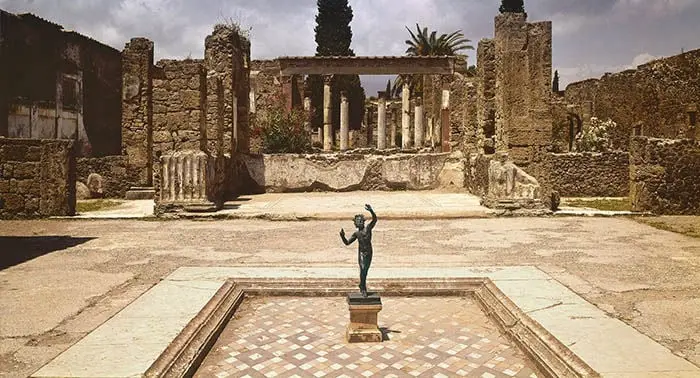
Audioguide 7 – The Thermopolia
The thermopolia in ancient Rome were small rooms with a peculiar counter built in stone, lime, or mud, which had vessels set into them that served to keep food warm. These counters were often decorated with colorful frescoes.
These were therefore little shops where you could buy ready-to-eat food. In the Roman world, they were very popular; just in Pompeii, there were about 80 thermopolies. These were very popular, especially among the inhabitants who could not afford a private kitchen.
If we think about it, it's something similar to what we know today as street food vendors!
One of the latest discoveries from the excavations and archaeological studies carried out in the city has been the thermopolia found between the alleys, "Las Bodas de Plata" and "Los Balcones" of region V, which offers numerous frescos on the counter that you can observe with the audio guide.
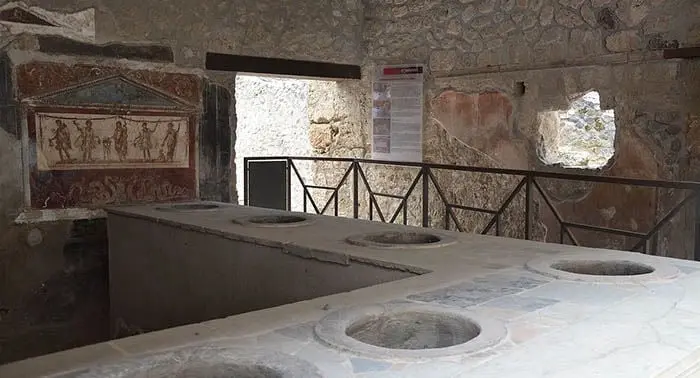
Audioguide 8 – The Stabian Baths
In Ancient Rome, not everyone could afford to have their own bathroom at home, so public baths were very common, attended by commoners or slaves. These buildings were called "thermae," while the private baths were called "balneum."
The baths were not just buildings for bathing, but they also covered much more, as we will discover in this section of the audio guide.
The rooms were reserved for gymnastic and recreational activities, considered meeting places, where emperors sometimes granted free baths to the rest of the population.
Four public baths have been identified in Pompeii: the Suburban Baths, those of the Forum, the Central Baths, and the Stabian Baths, which were the largest and most renowned.
Located between Via Estabiana and Via della Abundancia, they are the oldest in the city, dating back to the 4th century BC.
There were two sections: one male and one female. And for the comfort of the Romans, hot air circulated under the floor and between the walls... Yes! They had already invented a heating system by that time because cold has always existed!
Both the female and the male sections had four compartments: a dressing room, one with a cold water pool, a warm one, and finally one with a hot water bathtub and a warm water fountain.
I'm sure you're feeling like teleporting to the past and taking a bath, but... Do you think this is it? Not really. There's more: they also had a large outdoor swimming pool and a gym with a sundial.
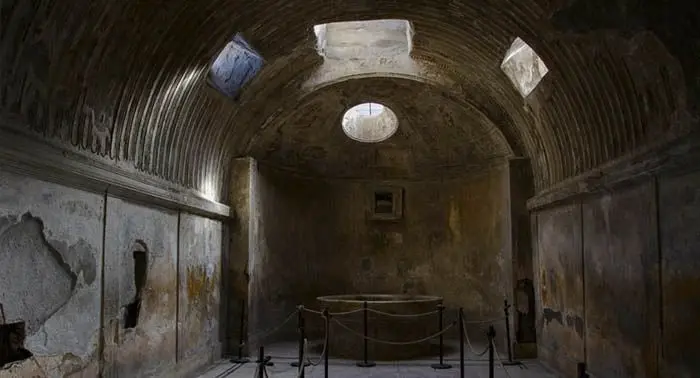
Audioguide 9 – The Forum
Since the beginning of time, people have met at an important point in the city, usually in the main square.
This was already happening in the Roman Empire, specifically in the Forum, where we now find ourselves with the audio guide.
In Pompeii, we can enjoy this great monumental square which represented the center of the political, economic, and religious life of the town, in region VII.
The place began to be built in the fourth century BC with shops made of lava, volcanic tuff, and clay.
Later, after the Roman conquest in the second century A.D., it was expanded. And like everything they built, it was not going to go unnoticed! Thus, the perimeter of the square took shape through columns made of tufa and white limestone, which surrounded iconic buildings of a political and religious character.
The Forum was undoubtedly the heart of the city, where the Romans met below the Temples of Apollo and Jupiter, or in the Basilica. We also find the Mensa Ponderaria in this forum, a building housing varying weights and measures that helped the inhabitants in their commercial endeavors.
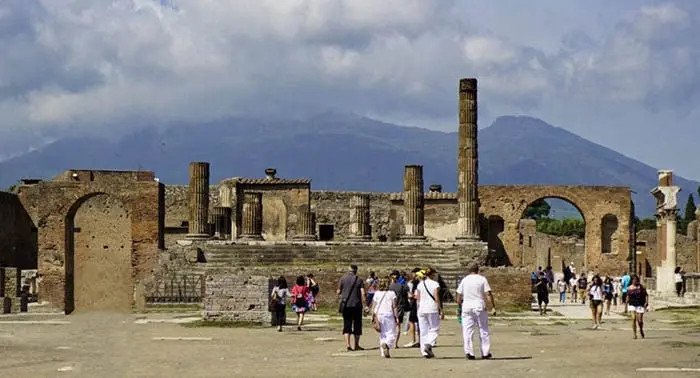
Audioguide 10 – The Temple of Apollo
We continue inside the Forum, concretely to the west, to stop to contemplate one of the most important religious buildings of the city, and previously named: The temple of Apollo.
Apollo, whose worship was imported from Greece, was one of the most revered gods of Mount Olympus. Do you know Greek mythology? He was the son of Zeus, himself, and Leto.
It is difficult to specify exactly the qualities for which everyone admired him, as they are innumerable. He was recognized, for example, as the god of healing, reason, the protector of shepherds and sailors... Always represented with a bow and arrow, we can summarize his figure as the god of the Arts.
Knowing his origins, we understand why Apollo had one of the most ancient temples in Pompeii: its construction dates back to the 8th or 7th century BC.
If we look at the interior of the enclosure using the audio guide, we find a gallery of columns made of volcanic tuff surrounding the patio. Inside, the figures we see are replicas of the originals of both Apollo and his sister Artemis' bust.
On the other hand, the temple as such is located at the end of the courtyard, and we access it by going down a staircase. In the center presides a white marble altar; and next to the steps, on an Ionic column - of course! - a sundial to send time information from the skies to the temple itself.
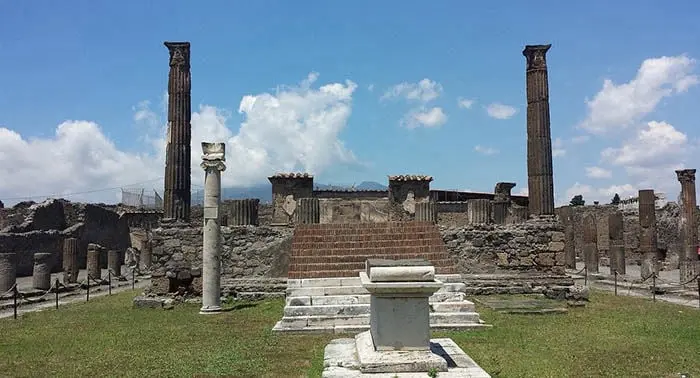
Audioguide 11 – The Macellum
We find a market in every city, right? Pompeii was not to be left out. Their market, in the forum, was called the “macellum,” and at this point in the audio guide, you will learn many things about this building.
It was a covered building, in which provisions, meat, and fish were sold. It was especially busy in Pompeii, as products were also imported thanks to the port.
The Macellum was built around a central courtyard, and along its facades were a number of food shops. Twelve of them were accessed via the street, and another eleven through the courtyard.
The area on the east side of the Macellum, divided into three rooms, is of special interest to archaeologists: one of them could have been dedicated to the imperial cult, another to the religious cult, with sacrifices and rituals; and finally, the third was for the sale of meat and fish.
Could it be that they made offerings and rituals as a symbol of gratitude, before selling those foods? Auction meetings? Sacrificial banquets and religious ceremonies? Perhaps.
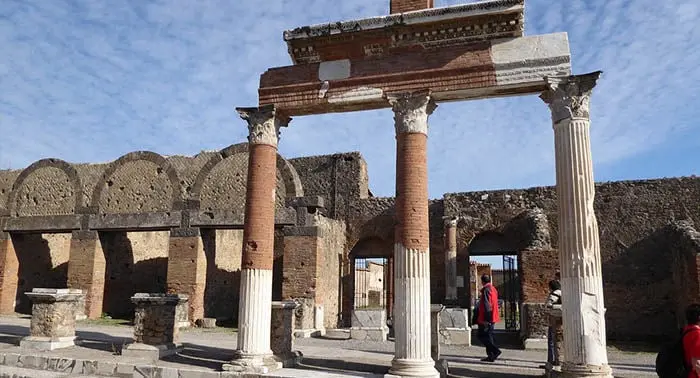
Audioguide 12 – The Basilica
The basilicas of ancient Rome were usually large rectangular buildings where the authorities and the population dealt with municipal, commercial, and judicial matters. They consisted of a large nave in the center and several porticoes on the sides that allowed light to enter from above. Normally there was a semicircle for the court in front of the main door and at the back of the nave.
But the Basilica of Pompeii is different. This has given rise to controversy about whether or not it was used for this purpose, and whether or not it was this type of building.
This is because it does not have a semicircle and does not have an upper gallery as in the rest of the basilicas. For this reason, some researchers claim that this building could be the "comitium," a place where the inhabitants elected their governors.
Even so, the similarities are greater than the differences, which is why it remains known today as the Basilica.
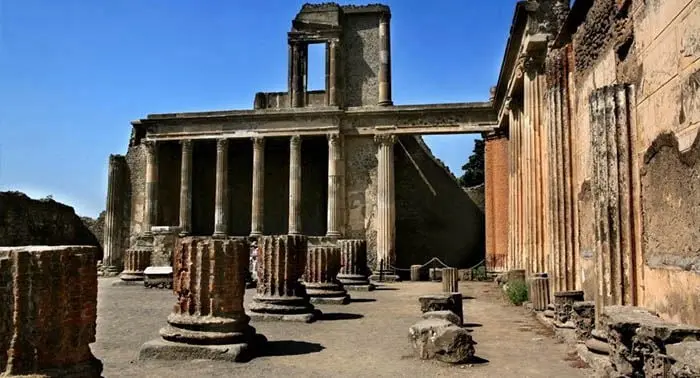
Audioguide 13 – The Temple of Venus
Using the audio guide, we find the temple dedicated to Venus, the goddess of love, beauty, and fertility, right behind the Basilica.
The building was subject to constant looting and the sanctuary was under construction at the time of the eruption, which is why it is very difficult to interpret today.
Even so, due to its characteristics, the new construction was going to surpass the previous one.
Raised on a tufa podium, and surrounded by a portico decorated with marble, we can sense that the aim of the temple was to be the most majestic and remarkable of Pompeii's religious buildings. This is obvious since its foundations were laid on the west side of the hill, high up, and in a north-south direction, so that the sanctuary enjoyed views of the sea and the Sarno river.
Can you imagine the sunset from here?
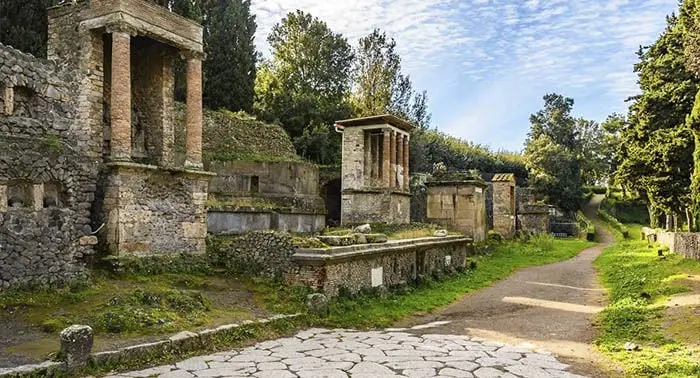
Audioguide 14 – Marine Gate
The next stop on the audio guide, this gate is located next to Tower XII and leads into regions VII and VIII of the city, giving rise to the name to the street that follows it: Via Marina. It is the closest gate to the sea in Pompeii, hence its name.
This gate was one of the busiest, as it served as an entrance and exit for merchants.
It was divided into two arches, one for pedestrians and the other for carts, although it is thought that many could not manage its vast extent and merchants divided their cargo into small carts.
At the same gate, there was also a stone bench, possibly to alleviate the fatigue or wait of the newcomers, after the long journeys.
It was, without a doubt, a gate with a lot of life, which it still has today, since it is the entrance to the archaeological park.
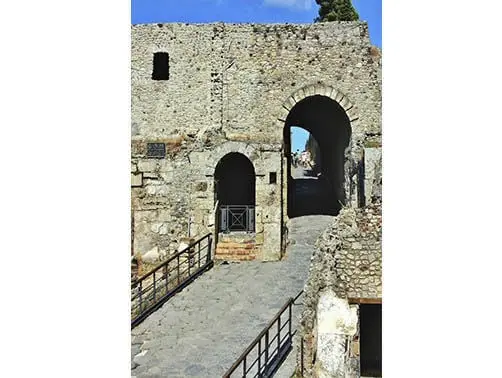
Audioguide 15 – The Triangular Forum
Apart from the main forum, in Pompeii we also have a triangular forum, so called because of its unusual geometrical shape, and surrounded by 95 Doric columns.
In the southern part of the forum, and also of Doric order, an imposing temple was erected which was the first structure in the place. This temple is possibly the oldest in the city, being built by the inhabitants in the 4th century B.C. to worship Hercules, whom they considered the founder of Pompeii. Later, Athena, also called Minerva by the Romans, was worshipped, too.
Continuing the visit with the audio guide, you will find a "tholos," a simple building consisting of a circular colonnade, and in this case, a well is also located inside.
On the other side, in one of the corners of the forum, three altars were built of tufa, and in the other, a stone bench to be able to enjoy the views of the plain of the bay of Naples that was right in front.
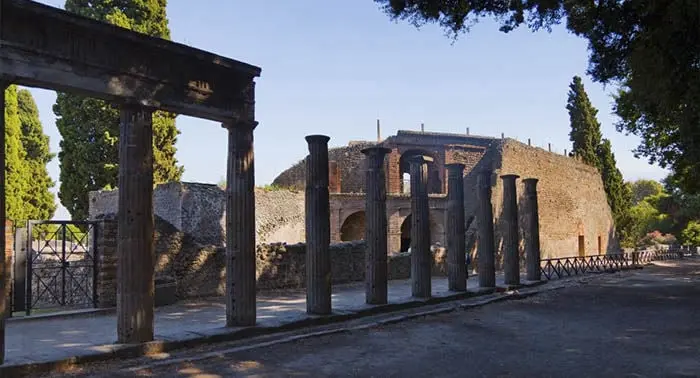
Audioguide 16 – The Grand Theater and the Small Theater
If I were to mention an amphitheater, what would we imagine? We would imagine a complete circular enclosure. What about if we were to think of a theater? We would imagine a semi-circle. So, let's take the audio guide and discover the theaters of Pompeii!
Construction began on the Grand Theater in the Samnite era, between the seventh and third centuries BC and if we observe its characteristics, we can clearly differentiate details of the Greek era.
For example, it was very common for the Greeks to build the theaters on the slopes of the hills like this one, taking advantage of the unevenness to locate the stands and thus provide spectacular views of both the stage and the panorama behind, in which, in this case, is predominated by the Sarno Valley and Lattari Mountains.
Also, the shape of the stage is not just semi-circular, as in Roman theaters, but it is ultra-semicircular, almost closed, also called a horseshoe stage.
The Great Theater could hold about 5000 spectators and had stands divided into three sections according to social class, and two parodos, which were passages leading to the orchestra.
The performances that were reenacted were great works, while the musicals, mimics, and poetry recitals were done in the Small Theater.
The Small Theater also called the “odeon,” had a capacity of 1300 spectators. It was built in 80 B.C., next to the grand theater. Its structure was very similar but with much smaller dimensions, which stopped the spread of sound and created perfect acoustics for the type of show being performed.
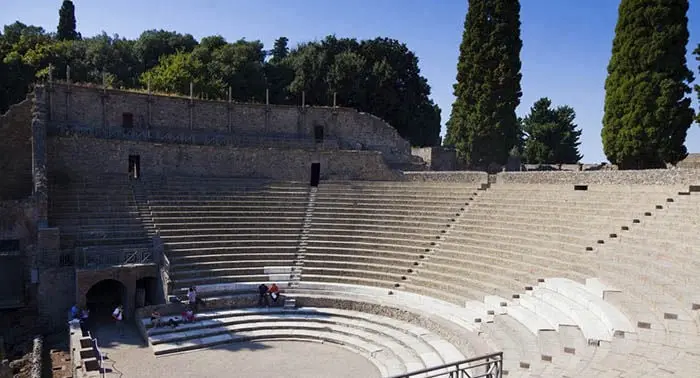
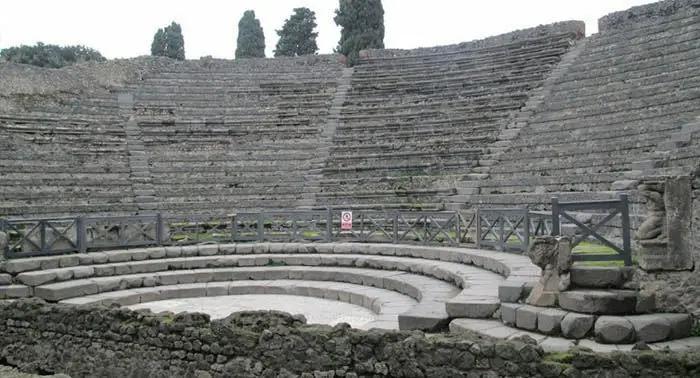
Audioguide 17 – The Gladiators’ Barracks
Behind the great theater was a porch where the spectators could entertain themselves before the show and during the breaks. It would be like the typical welcome drink or the open smoking room of a venue today, so you can hang out while waiting for the show to start.
This enclosure we have now arrived at with the audio guide was something like this. But after an earthquake in 62 AD, the area became the Gladiators' Barracks, where they and their families were housed.
We know the importance of these people in the life of Ancient Rome, and therefore they all had a common place to live. Here they grew up and learned to fight. It was a large rectangular exercise and training yard, surrounded by 74 columns, 10 cells, cubicles for housing, and weapons stores.
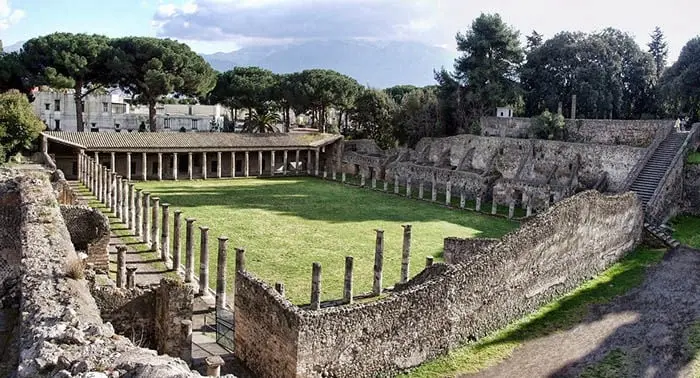
Audioguide 18 - The Lupanar
"Lupanar" was the word used by the Romans to identify a brothel. And it comes from the word "Lupa," which even today, in Italian means "wolf."
And how, after the excavations, was this place considered to be a Lupanar? Because of the frescoes.
The paintings were of erotic content and were usually found in front of the doors to the rooms.
After archaeological studies, every place where Pompeian frescoes of this type have been found has been declared a brothel; but in this case, following the audio guide, we are looking at the largest in the city, with ten rooms.
Inside the room, you can see different frescoes, in addition to the carved stone beds. Another interesting fact is the graffiti: 134 Latin phrases written on the walls by customers or people who worked here, in which some of them continued and responded to the previous one as a dialogue.
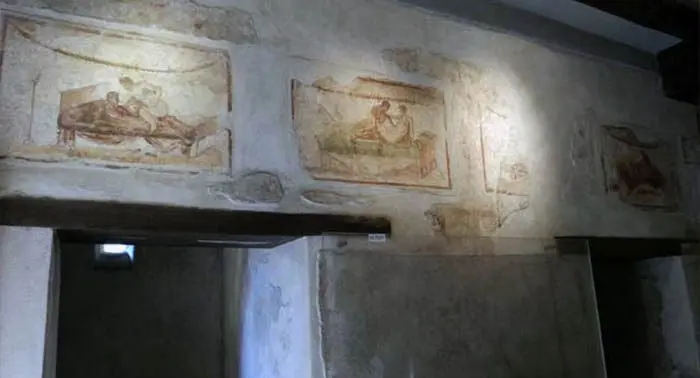
Audioguide 19 – Garden of the Fugitives
It is quite difficult to calculate how many inhabitants of Pompeii lost their lives instantly due to the 300 to 600ºC temperature of the volcanic cloud. At the time of the disaster, the city had about 15,000 inhabitants. Counting on the fact that the volcano began to show signs of activity days before, many Pompeians escaped, especially by sea.
When archaeologists discovered what human bodies were, they did their best to preserve them as they were. To do this they used plaster. How?
Put yourself in this situation: first, there is the skeleton, then the organic matter of the body, like flesh, and then layers and layers of ash.
Thus, between the skeleton and the layers of ash, there was a gap resulting from the decomposition of organic matter, and this gap was filled by injecting liquid plaster. When the plaster dried, it was solidified, entering into the empty space and giving complete form to the bodies as they were at the moment of the disaster.
Thus, the bodies found were recovered using this method, and the most complete set of molds we have is in what is known today as the Garden, or Garden of the Fugitives. This was a large area possibly cultivated with vineyards, and where the Pompeians tried to escape through the walls to leave the city at the time of the explosion.
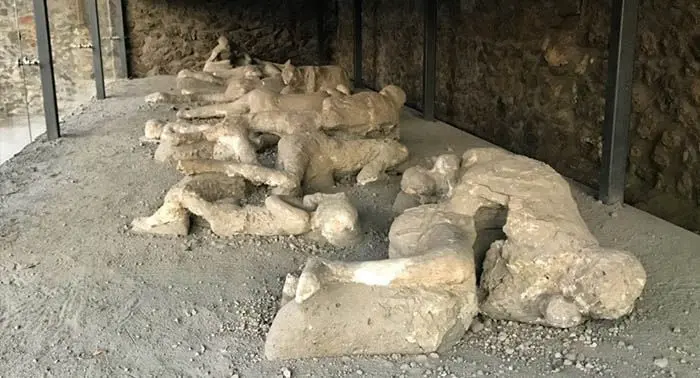
Audioguide 20 - Other interesting places in Pompeii: Private Homes
As a general rule in other tourist locations, we focus on public buildings. But Pompeii, so different from everything else, offers us not only the public but also private houses.
This fact allows us to have much closer and genuine contact with those who were the inhabitants of the city.
The Roman houses we are going to see were called "Domus." Do you know why? The owners of these residences had a certain economic status, and the head of the family was called "Dominus," which meant "master," or "lord." Hence the word, "Domus."
Apart from "The House of the Faun," or the Villa of the Mysteries, which we will talk about in the next point on the audio guide, we have very interesting live-ins in Pompeii, such as those we will describe below:
• Menander House: Located in Region I and occupying an area of about 1800 square meters, this residence is a very good example of the luxurious Roman domus of the time. It was excavated between 1926 and 1932, not so long ago, and its name is not due to the owner of the house, whose origin is unknown, but to the fact that an image of the poet Menander, the Greek comedian and greatest representative of the new comedy, was found there.
• The House of the Tragic Poet: This domus is located in Region VI, in Via delle Terme. It is not large in size, but its interior decoration is exquisite. The quality of its frescoes and mosaics is higher than others in the city, and they describe scenes from Greek mythology.
• The House of the Small Fountain: In the Vicolo Di Mercurio, we find this house that stands out due to its little fountain, which is decorated with mosaics and sculptures.
• The House of Octavius Quartio: On Via della Abbondanza, this residence is named after its owner. It is noteworthy for its large gardens and several frescoes. Additionally, the famous mural of Venus is on the side of this house.
• La Casa Dei Quadretti Teatrali or Casca Longus: Also on Via della Abbondanza and at the corner of Vicolo del Citarista, this domus has a majestic marble table with lion sculptures on its interior. We can also admire its frescoes, inspired by works of Euripides and Menander.
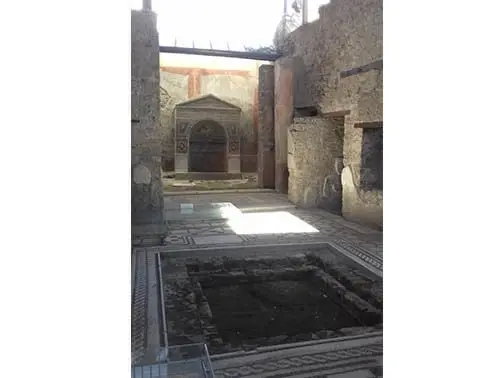
Audioguide 21 – Villa of the Mysteries
At about a 10 minute walk with our audio guide from the forum towards the northwest, and 200 meters from Herculaneum Gate, we find the Villa of the Mysteries.
It is a large villa built in the second century BC and located on the outskirts of the city. We can also tell you that it was practically intact under the ashes from the eruption, especially the walls, ceilings, and in particular the frescoes.
It is not known who the owners of the Villa were, but it is known that it went from being a stately home to an agricultural entity after the earthquake in the year 62. The origins of the different objects found make us think that the owners could have been multiple families and eminences: a statue, a bronze seal, a booklet...
There are several rooms, both for leisure and for rest, but the most striking are the frescoes on the walls of the so-called "room of Dionysian mysteries," so well preserved and... so mysterious or possibly "taboo," hence the name of the place.
The paintings are from the first century B.C. and deal with scenes that are difficult to interpret. Most of them depict a young girl who could be the daughter of the family, going through rituals in which excesses predominated, and worshiping Dionysus, considered by the Greeks as the God of fertility and wine.
The scenes are very expressive and generate considerable controversy, for example, an old man offering a drink to a teenage boy and a theater mask.
These scenes are distributed over three of the room's four walls, creating continuity from scene to scene, resulting in a progressive narrative.
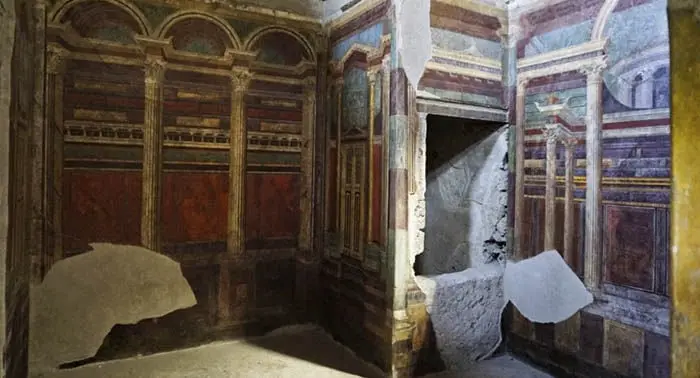
Audio guide devices, Multimedia audio guides,
Audio guide GPS tourist bus-train, charging bases and accessories.
Group guidance systems, headsets, charging cases, tour guide systems accessories.
Audioguides available from mobile devices, web App, downloadable App from Google Store.
Audioguides in several languages, translations, voiceovers. Audio descriptions, signoguides, visual contents for audioguides. 3D Reality.